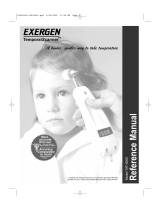
HEART RATE SENSOR 027i
User’s Guide
CENTRE FOR MICROCOMPUTER APPLICATIONS
http://www.cma-science.nl
Figure
1
.
The Heart rate sensor

2
Description
The Heart rate sensor 027i provides a simple way to study the heart's function.
Unlike an electrocardiograph (EKG), which monitors the electrical signal of the
heart, this sensor monitors the flow of blood through the veins.
The Heart rate sensor is equipped with a BT-plug and can be connected to the
following CMA interfaces: €Lab, CoachLab II/II
+
and ULAB. Furthermore the
sensor can be used with Texas Instruments CBL, CBL2 and Vernier LabPro.
Sensor specifications
The Heart rate sensor has a memory chip (EEPROM) with information about the
sensor. Through a simple protocol (I
2
C) the sensor transfers its data: name, quantity,
unit and calibration to the interface
1
.
How the Heart rate sensor works
The sensor clip consists of a small infrared LED and an infrared light sensor. As the
heart forces blood through the blood vessels, the amount of blood changes with
time. The sensor measures the light level transmitted through a tissue of the ear lobe
and the corresponding variations in light intensities that occur as the blood volume
changes in the tissue. The clip can also be used on a fingertip or on the web of skin
between the thumb and index finger. The measured signal is amplified, inverted and
filtered.
By plotting the measured signal
some details of the pumping
action of the heart can be seen
on the graph.
Figure 2 shows that the blood
flowing through the earlobe rises
at the start of the heartbeat. This
is caused by the contraction of
the ventricles forcing blood into
the arteries. Soon after the first
peak a second, smaller peak is
observed. This is caused by the
shutting of the heart valve, at the
end of the active phase, which raises
the pressure in the arteries
and the earlobe.
In the Coach program you can determine the heart rate by analyzing the time
between peaks, or counting the number of beats per minute by using the heart rate
1
This is valid for the following interfaces: CMA €Lab, BT inputs of CoachLab II/II
+
and ULAB,
TI CBLand CBL2, and Vernier LabPro.
Figure
2
.
A sample measurement with the
Heart rate sensor.

3
sensor as counter with a threshold of e.g. 32%
Heart rate varies between individuals. At rest, an adult man has an average pulse of
72 per minute. Athletes normally have a lower heart rate than less active people.
Children have a higher heart rate (approx. 90 beats per minute), but also show large
variations. The heart rate rises during exercise and returns slowly to the rest
frequency after exercise. The rate at which the pulse returns to normal can be used
as an indication of fitness.
Note:
Notice that the Heart rate sensor cannot be used during the exercises. The body’s
movement would cause shifting of the ear clip and erroneous readings.
The ear and clip should be shaded from strong light.
The Heart rate sensor is not appropriate for medical or research applications.
Specifically, it may not be used for patient diagnosis.
Examples of experiments
- Measurements of the heart rate of different individuals.
- Measurements of the heart rate before and after exercises.
- Measurements of the recovery rate: how fast a person's heart rate returns to its
normal performance after exercise.
- Measurements of the heart rate before and after eating or drinking coffee (or
Coca-Cola).
- Simultaneous measurements of heart rate, EKG and heart sounds with sound
sensor to register heart tones.
Calibration
The output signal of the Heart rate sensor reflects variations in the amount of
transmitted light. Irrespective of the average amount of transmitted light (much
more through the ear lobe as through the fingertip) the output signal will always
vary around an average of 1.5 V (30%). Due to movements of the clip, the average
light level will change; the output voltage will make a shift but will find its normal
average of 1.5 V within a few seconds. To collect data you can:
1. Use the calibration supplied by the sensor
EEPROM memory.
2. Use the calibration supplied in the standard
sensor library of the Coach program. The name
of the Heart rate sensor in the sensor library of
Coach is Heart rate sensor (027i) (CMA).
Figure
3
.
Default calibration graph of the heart rate sensor
(used in the standard Coach sensor library and in
the sensor memory).
I (%)= 20 * V
out
(V)
Coefficients of the calibration function:
a= 20; b= 0.

4
Technical data
Voltage output range 0 – 5V
Amplitude Each heartbeat gives a peak. If the peak is less than
0.2 V the ear clip should be repositioned.
DC-level 1.5 V
Frequency response Band-pass filter 2.4 – 12 Hz
Supply voltage / Supply current 5 V DC / 12 mA
Sensor information for
Auto-ID and calibration 256 byte serial EEPROM
Ear Clip An infrared LED and a light sensor.
Connection Right-hand BT (British Telecom) connector
Warranty:
The 027i Heart rate sensor is warranted to be free from defects in materials and
workmanship for a period of 12 months from the date of purchase provided that it
has been used under normal laboratory conditions. This warranty does not apply if
the sensor has been damaged by accident or misuse.
Note: This product is to be used for educational purposes only. It is not appropriate
for industrial, medical, research, or commercial applications.
Rev. 1/11/12
/
